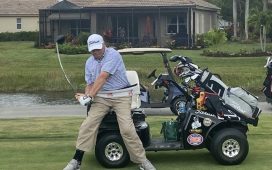Introducing the goal for an additional nine holes at Ol’ Colony golf course, Brion Hardin approached the green first at Tuesday’s Tuscaloosa City Council finance meeting.
“I’m just breaking the ice,” said Hardin, a member of both the Ol’ Colony and the Tuscaloosa County Park and Recreation Authority (PARA) boards of directors. He spoke and answered questions for the council, to which he handed out copies of a several-page package explaining how the additional nine holes could alleviate ongoing needs, and generate revenue at the course.
Ol’ Colony was designed by Jerry Pate, a University of Alabama graduate who won the U.S. Open at 22, in 1976, his rookie season as a pro. It serves anyone from seniors to members to those who can pay $65-weekday greens fees and is a home course for numerous school teams, including Shelton State Community College, and several local middle and high schools. It hosts numerous fundraisers and has been home to an NCAA regional, the Southern States Invitational, the Alabama Open, the Alabama State Amateur and match-play championships.
UA’s golf team made Ol’ Colony its home course, and constructed a training facility, the Jerry Pate Center, on its grounds in 2005. However, the Capstone is in the process of developing its own golf training facility for men’s and women’s programs. Athletic director Greg Byrne in February introduced a proposed $26,840,000 complex, one the UA System board of trustees approved in early February.
Once constructed, the UA facility will include a new nine-hole course, driving range, short-game practice area and 18,000-square foot golf house. It’s to be developed on 176 acres south of Jack Warner Parkway, west of 25th Avenue Northeast, and along each side of Kicker Road.
Ol’ Colony also serves 13,000 kids with its junior golf programs, including a junior tour, teaching facility and annual benefit fundraiser. Opened in 2000, Ol’ Colony requires, as do all courses, near-constant maintenance. But rising demand for tee times makes it tough to squeeze in the necessary upkeep while also serving the community, Hardin said, within its current capacity.
“It just can’t do it anymore,” he said.
An additional nine holes, bringing the course to 27, would allow staff to rotate down time on stretches for upkeep and repairs, and also host 18-hole tournaments while keeping space open for local golfers to get in their swings.
“It’s going to make money,” Hardin said, “but let’s say we re-do the greens … you have to do that in the middle of summertime. You’re going to lose about a half a million dollars worth of revenue.
“You’ve got the other nine, you’re not going to lose anything,” by shutting down nine at a time for the grounds work, in rotation.
As operated by PARA, the championship course receives funding from the city of Tuscaloosa, the city of Northport and the Tuscaloosa County Commission.
Though no commitments were made or asked for at the city finance meeting, Hardin helped underline reasons for the requested expansion, said Mayor Walt Maddox, preparatory to a later ask for additional funding.
“He is wanting to place (the expansion idea) on the radar of the three local governments,” Maddox said.
PARA is ready to move on this, Hardin said, and design could be completed in a matter of months, with construction taking possibly another nine months, he estimated. The proposal shown to the council featured a rendering by Pate, who after retiring from the pro tour created a golf course design and turf and irrigation company.
Pate has donated probably hundreds of thousands of dollars worth of services, Maddox said, adding “He’s always given back to this golf course.”
The proposal would situate the additional nine across Northridge Road from the existing 18, in an undeveloped expanse of land from Northridge Middle School to PARA’s Buddy Powell Pavilion.
After meeting a few weeks back with Hardin and Tuscaloosa County Probate Judge Rob Robertson, Maddox felt encouraged that Northport and the county are also steadfastly behind the Ol’ Colony expansion.
“… We think putting together a master plan for the course, a series of improvements, would be the natural step,” Maddox said, to indicate what could be done initially, what might evolve in stages, and what types of revenue would be generated, offsetting future operating costs, “and then come back and look at putting into funding cycles for … city, county and Northport.
“Because this golf course, we think, has the ability to really be a tourism draw.”
In a June story for The Tuscaloosa News, Pate talked about his original concept for Ol’ Colony including two full 18-hole courses.
“We still have enough land to do 27 holes,” he said. “My original concept … was going to be that the course was strong enough and the community could support something like a women’s U.S. Amateur or a men’s U.S. Amateur because they need 36 holes – or an NCAA championship or the regionals. So we certainly thought it had the ability to host any kind of tournament entity.”
This fall, Ol’ Colony will play host to the Tuscaloosa Toyota Classic, the final regular-season stop on the Epson Tour, a qualifying feeder into the LPGA, September 29-October 2. About 120 golfers from 30 countries will play 54 holes that weekend. Pate has traveled to help oversee preparation at Ol’ Colony, which has been adding new sand to bunkers, aerating the roughs and fairways, and repairing some winter kill on the greens.
Maintenance is a continual task for PARA, with more than 2,000 acres of green spaces over 35 parks, seven activity centers, 36 playgrounds, boat landings, tennis facilities, islands and the 597-acre Ol’ Colony.
“There’s always kind of an ongoing maintenance, tree leaves and things, leaks; parts just getting old and having to be replaced,” said Gary Minor, PARA executive director.
“And a golf course in general, there’s just a lot of maintenance because the sheer amount of grass they have, especially Ol’ Colony, which is a long course … and the hybridized type of grass on the greens.”
Aeration is nearly constant, to keep water traveling down to roots, and helping keep the courses pest-free, Minor said.
“If you’re aerating greens, you’ve got to put machinery out, rub all those dirt clod plugs, pulverize ’em, then let it fall back into the green,” he said. “You can’t just run out and do that, and get out of the way while somebody lines up a shot.”
Simply keeping the grass trimmed to precise performance levels remains a major focus.
“Golfers want the ball to roll really fast,” he said, “but you can’t cut the grass too low without it turning brown.”
Those issues get multiplied as a course sees near-constant usage, such as Ol’ Colony, not just for the lack of shut-down time for maintenance, but as compression and impact on the grasses deepens due to thousands of feet.
Unlike many activities during the shutdown phase of the pandemic, golf experienced an upsurge, Minor said. For fear of contagion, most indoor, children and family activities were canceled for a period.
“PARA probably stayed closed down less than any other parks and recreation in Alabama, but gyms were closed, and for a little while you couldn’t go to a pool,” he said, until studies were found that chlorine used to disinfect pools resulted in a “complete inactivation of SARS-CoV,” the causative agent of COVID-19.
“Going outside, to the golf course, became a way for people with maybe a little more time on their hands to socialize and exercise,” Minor said.
Maddox, who has only recently taken up golf, saw a packed house the most recent time he visited the driving range, an extensive and diverse crowd of players.
“It was really Tuscaloosa out there on the golf course,” he said.








